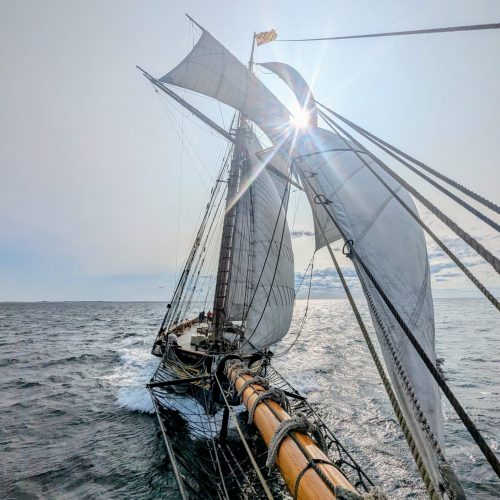Date: Tuesday, June 20, 2017
Sail Training International’s Rendez-vous 2017 Bermuda to Boston race results are now official: 1st place in Class B goes to Pride of Baltimore II.
(…and the crowed roared…joke…maybe the roar we imagined merely whispered in our minds …).
2017 back-to-back 1st place wins by Pride of Baltimore II are now recorded in international tall ship sail training race history (via two Captains who alternated between the two races). No other American sailing vessel participating in international tall ship races has Pride’s record of 1st in class stretching back to her first 1st Class B win in the millennium year 2000 transAtlantic (eastbound Nova Scotia to England) tall ship sail training race.
In the 2000 race, as well as in the 2009 Bermuda to Charleston race, and in these two recent races (Charleston to Bermuda and Bermuda to Boston) Pride was the first of the larger vessels, as well as the first traditional wood constructed and oldest rig style vessel in the racing fleet to cross the finish (she models the American Baltimore Clipper of the War of 1812 privateer fame). But she was not the first competitor to finish ( except for the 2017 Charleston to Bermuda race when Pride was actually the first vessel to cross the finish line). The vessels that led Pride across the finish line have all been the smaller, shorter, more modern 20 and 21-century sloops and ketch rigged vessels. Being shorter, they are to be complimented for besting Pride’s longer waterline. Being a much heavier vessel, I think Pride can be complimented for staying as close as she did to the smaller, lighter, and more modern vessels.
Setting aside, for the moment, any pride in performance, even more to be celebrated is the more than half a century of these international sail training tall ship races. They have been and continue to be wonderful cross cultural & cross national adventures by those of all ages (15 years and more) who have the gumption to do something very few others have the gumption to do.
Sailing traditional and modern sailing vessels is not for the faint of heart. It is not about risk, however – sailing is one of the safest group activities around. But it does take gumption to be willing to go beyond one’s imagination of a sea-going voyage and actually do it and commit to going. A great deal of separation from the norm of societal opportunities occurs when one goes voyaging over the horizon beyond the sight of land aboard a sail training tall ship. It’s crowded with little privacy. You are disconnected from everyday communication with friends and family. Collaboration and group challenges with shipmates, most often previously unknown to you, happen day and night repeatedly and uninterruptedly for as long as it takes – could be for a few days to as long as a month. You are doing something you have little to no previous familiarity with, while being instructed and led by a core group of professional crew, who are fully interested in sharing their knowledge and experience.
So there you are – out of sight of land, extending the time from your last shower to your next shower. Shoulder to shoulder, elbow to elbow, hip to hip with others who are your shipmates, responding together to the unforgiving sea and always changing weather elements in a vessel heaving and lurching to the motion of the sea – using those elements to get to the finish line sooner than the rest of the fleet. An international fleet can number from more than a half dozen vessels to over one hundred participating vessels ranging in overall lengths from a little less than 50 feet to over 300 feet, all making the same effort to get to the finish, through changes in seagoing weather, ahead of the others to win the bragging rights and self-satisfaction for overcoming the strangeness of new challenges in a long proven, many centuries old, means of transportation. Don’t forget the importance of making and cleaning up meals three or more times a day no matter the conditions and the motion, as well regular daily (or more frequent) cleaning of other facilities used by all aboard, and keeping your own stuff in your own space aboard a universe limited by length, breadth, and depth shared by as many as can be fit aboard.
While competitive performance is fun, the record established in a history of records is wonderful…what is best and most fundamental, are the successes of the very small isolated “island” societies that are the individual vessels with their crews of many ages & nationalities, most of whom have not been to sea at all before, successfully managing their vessels safely to the end of the race. Ending up in the destination port is a great celebration for the safe and vigorously accomplished sailing adventure from the previous port, gaining new friends from those that used to be strange shipmates along the way.
And so a toast…
Hail to the accomplished crews of Sail Training International’s Rendez-vous 2017!
Signed,
Captain Jan C. Miles







